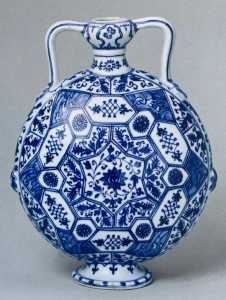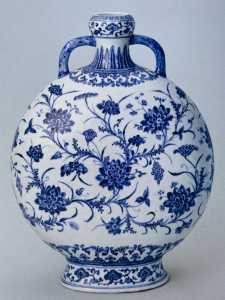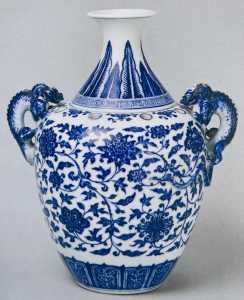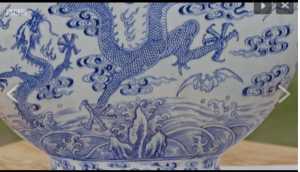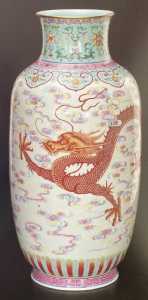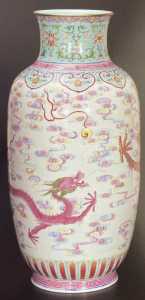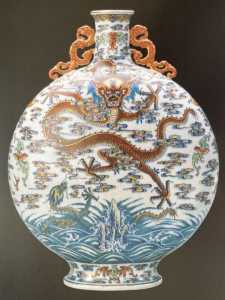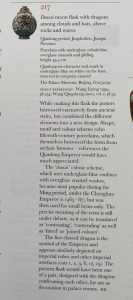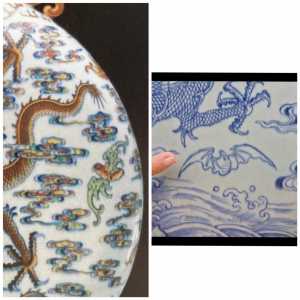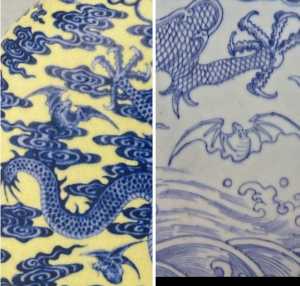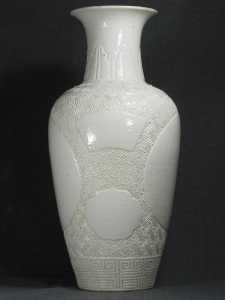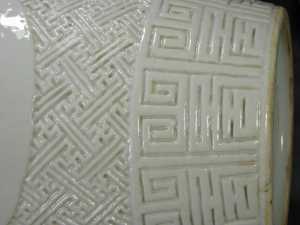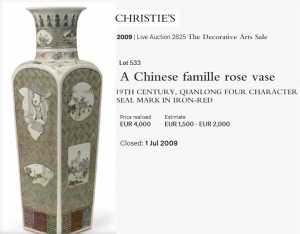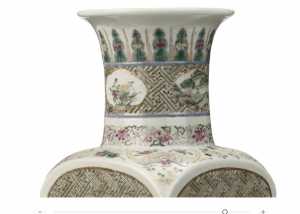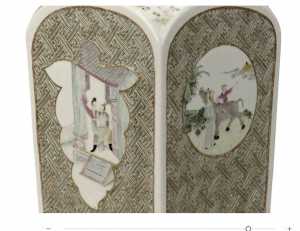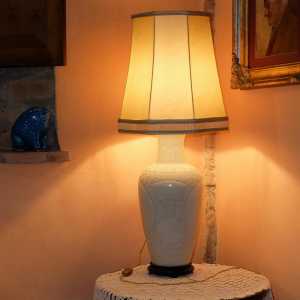The Chinese and Asian Art Forum. For Fans, Collectors and Dealers.
 Basic Rules For the BidAmount Asian Art Forum: Talk about whatever you want. You can even discuss and offer things that are for sale if they are authentic. Maximum image file size per post is 2 MB. Images of 700pxl x 700pxl are optimal if saved at a medium resolution. Be respectful of others and enjoy yourself. Click the YouTube link for a brief tutorial on using the forum. You can also EMBED Videos by cutting and pasting from You-Tube, Vimeo etc.
Basic Rules For the BidAmount Asian Art Forum: Talk about whatever you want. You can even discuss and offer things that are for sale if they are authentic. Maximum image file size per post is 2 MB. Images of 700pxl x 700pxl are optimal if saved at a medium resolution. Be respectful of others and enjoy yourself. Click the YouTube link for a brief tutorial on using the forum. You can also EMBED Videos by cutting and pasting from You-Tube, Vimeo etc.
NOTE: To post an item or add a new post, click open the category title from the FORUM LIST, and CLICK the Blue ADD TOPIC button.
Hi Jeremy -
My understanding is these Imperial marks could be written in underglaze blue, which was fired together with the body at high temperature, or they could be done in overglaze blue, red or gilt and then fired a second time, usually at a lower temperature. For monochromes, the marks were mostly moulded or incised ..
Stuart
Hi Steve -
The Qing Imperial kilns used a wide rang of differing handles, some of which look back to previous dynasties ie: Ming, and others that were newly designed, predominantly from the Yongzheng period onwards ...
Attached images of three Yongzheng m/p examples, all from the Palace Museum, Gugong Beijing ...
Stuart
Thank you Stuart.
I have seen the overglazed blue and red reign marks that were used on ducai decorated cups and bowls, but I would have thought that a large vase with a significant amount of underglaze blue decoration would most likely have an underglaze blue mark and as you point out this would be fired with the body, not on the glaze and reglazed again.
Kind regards,
Jeremy
@nycat @ imperialfinegems
Hi Ang and Mark -
Yes, the fact that these rejected, misfired or lesser quality Qing Imperial wares were not destroyed but stored at Jingdezhen has only come to light through the study of historical sources, such as the ‘Zaobanchu’ archives, the Shilu (veritable records or the Qijuzhu (Court Diaries) in the last 15 years ...
So a very different practice then during the Ming dynasty, when such defeated/rejected Imperial wares were destroyed/buried as they were forbidden to leave the Imperial kiln site ...
The Zaobanchu cited above is by far the most detailed and important references, as it was set up in early early years of Kangxi, and contains a wealth of information pertaining to every aspect of life at the Imperial Qing Court ...
Stuart
Hi Jeremy and all -
That this flask does not carry an underglaze blue mark is not unusual, as I have seen both blue and red six-character QL seal marks on such pieces. The fact that this piece is ‘unfinished’, would indicate the mark would have been applied after the additional enamelling was completed ...
As an aside, the overall composition indicates the two dragons represents the Emperor, with five claws, and the designated Crown Prince, also five clawed, raising up from the waves to meet his father ...
This composition was very popular during YZ/QL periods, attached images of a large vase, H. 52 cm, red six-character QL seal mark/period, the large dragon in light iron-red, the smaller one in pink yet both with near identical scales and similar features ...
A stunningly beautiful piece, the clouds and subsidiary decoration painted in the famille rose palette, private HK collection ...
Stuart
Stuart
Am I mistaken in thinking the bat looks rather out of proportion and as if it were hastily drawn in? Mind you I have not seen verified genuine ones to compare it to.
Superb discussion! I learned a lot. I'm still skeptical that this piece is genuine - sorry. It's not the artistry specifically, although I think the general line work seems thick.
Those handles sure look odd. What are they? In-turned ruyi scepters? That's not how I've seen ruyi scepter handles....always out turned and upside down.
The firing crack on this vase is soooo large and unprofessional , that I hardly think that kind of mistake is even possible to occur at an Imperial kiln.
@greeno107 @opa127 @imperialfinegems
Hi Greeno, Paula, Mark and all -
Whilst looking for something completely different I come across this flask, attached image/description, from the Palace Museum, Gugong, Beijing ...
It was included in ‘China, The Three Emperors 1662-1795’, held at the Royal Academy, London, Nov 2005 - April 2006, which I visited four times ...
The handles are rather more elaborate, but the overall painting style and composition are nearly identical to the unfinished flask posted ...
Stuart
Hello Stuart
You are indeed a fountain of knowledge in regards to Qing ceramics. Even with my limited understanding of these wares I can see the beauty of the the vase that you have posted. What I cannot understand is the huge difference in the bats shown on the two different vases, even taking into account that one is supposed to be just an outline.
The bats on the doucai vase look to me like they have been painted with superb skill, whereas, the unfinished vase looks like the outlines of the bats are made up of joined up lines almost like they have been traced or have been drawn with french curves. Perhaps I am incorrect, I just don't have enough knowledge.
Kind regards,
Jeremy
Hi Jeremy -
You are far to kind, Qing wares are not really so my knowledge, as such, is limited and vary far from any ‘fountain’!! ...
You are correct, there are significant differences between the drawing/details between of the bats on this flask and the unfinished one original posted ...
However, if you compare the bats on the blue/yellow flask, also from the Gugong, that I posted on this thread, 29/03/21 page 2, with those on the RA exhibition above, you will see that the drawing is very similar on both pieces ...
These differences may be down to different artistic interpretations of the same Court approved design, or just how different artists, perhaps several decades apart, depicted this motif?! ...
But my thoughts only - I would be most interested to hear others view on this ...
Stuart
Hello Stuart
I understand what you mean about them being similar, but to my eye they seem like chalk and cheese. The bats on the vase that you have shown are not just clearly varied in posture, but even to a novice there seems to be a significant difference in the quality. As you say, it will be interesting to read the opinions of other members.
Kind regards,
Jeremy
Dear Jeremy,
I do not see that difference in quality between the bats. They are differently represented, but the quality is there. Especially if you take the bats of the last picture that you have shown, they are almost identical to me, it is just lack of shading.
Dear Stuart, thank you for reporting of that recording related to the discarded pieces.
In fact, one thing is if the object is already bearing the Imperial mark, another thing is if it has not been marked yet. There are no reasons for destroying it in the latter case.
Talking about these, I am showing here my baluster vase, with overall decorated with incised swastika decoration, that has been left blank probably because of a firing fault at the mouth. I like it very much; it is for sure of the Daoguang period.
It took years for finding out how it was meant to be. A Chinese friend of mine found an identical one, bearing a Qianlong mark in red. The panels were decorated with scenes in polychrome enamels, without blue outlines. All the ribs of the swastikas pattern were gold gilded. The quality was very high, Imperial quality I would say, and in fact my friend was convinced that it was an Imperial Qianlong vase, but it is Daoguang. He didn’t not allow me to take pictures because he was going to sell it. I do not know where is that vase now, probably in China.
I have also found a similarly decorated vase sold by Christie’s, but with different shape. Here are its pictures. You can see by it as it was meant to look my blank vase.
Regards,
Giovanni
PS: I transformed my vase into lamp.
@jeremy I think the quality is comparable. If it had been shaded and completed I don't think any of us would be doubting it.
Thanks for visiting "The BidAmount Asian Art Forum | Chinese Art"
If you sell on eBay, or have a shop feel free to post images and descriptions and links.
Check back often for discussion about the latest news in the Chinese art and antique world. Also find out about the latest Asian art auctions at Sotheby's, Christie's, Bonhams and Tajans.
Auction results for: fine porcelain, ceramics, bronze, jade, textiles and scholar's objects. As well as Japanese, Thai, Vietnamese and other Asian cultures.
Thank you,
Peter Combs
Topics and categories on The BidAmount Asian Art Forum | Chinese Art
Kangxi vases, Kangxi dishes and chargers, Kangxi ritual pieces, Kangxi scholar's objects, Qianlong famille rose, Qianlong enamels, Qianlong period paintings, Qianlong Emporer's court, Fine porcelain of the Yongzheng period. Chinese imperial art, Ming porcelain including Jiajing, Wanli, Xuande, Chenghua as well as Ming jades and bronzes.
The BidAmount Asian Art Forum | Chinese Art
A free Asian art discussion board and Asian art message board for dealers and collectors of art and antiques from China, Japan, Korea, Thailand, Cambodia, Vietnam and the rest of Asia. Linked to all of the BidAmount Asian art reference areas, with videos from plcombs Asian Art and Bidamount on YouTube. Sign up also for the weekly BidAmount newsletter and catalogs of active eBay listing of Chinese porcelain, bronze, jades, robes, and paintings.
The art of calligraphy - and for the ancient Chinese it certainly was an art - aimed to demonstrate superior control and skill using brush and ink. Calligraphy established itself as one of the major Chinese art forms during the Han dynasty (206 BCE - 220 CE), and for two millennia after, all educated men were expected to be proficient at it.
The Museum’s collections of Asian art span nearly five millennia and encompass the cultures of China, the Himalayas, India, Japan, Korea, and Southeast Asia. In 2007, the Museum launched an initiative to create dedicated galleries for the collection, beginning with a gallery for the arts of Korea ...
Chinese art is full of symbolism, in that artists typically seek to depict some aspect of a totality of which they are intuitively aware.
China Online Museum is the finest online museum of Chinese art. It features Chinese calligraphy, painting, ceramics, bronzes, carving, and other artworks.
Chinese Ceramics & Works of Art. Overview Upcoming auctions Contacts Auction results ... Christie’s sales of Chinese ceramics and works of art showcase centuries of Chinese history. Held throughout the year in London, New York, Paris and Hong Kong, they attract a wide audience of collectors and connoisseurs vying for pieces as diverse as ...
Explore Asian Art Week. Contact the Specialist Department. Chinese Paintings ... Senior Specialist, Head of Sale. [email protected]. Tel:+1 212 641 5760. Bid in-person or online for the upcoming auction:Fine Chinese Paintings on 10 September 2019 at New York. Bid in-person or online for the upcoming auction:Fine Chinese Paintings on 10 ...
Discover an abundance of must-see art from all corners of a vast continent at Christie’s NY Asian Art Week. From contemporary classical and Chinese paintings to works with exemplary provenance from the Art Institute of Chicago, our Rockefeller Paza galleries will be full of ancient treasures and contemporary masterworks in a salute to the vibrant arts of Asia.
Sold to benefit The Art Institute of Chicago’s Asian Art Acquisition Fund, the sale features 84 lots with a focus on Ming and Qing porcelains, and offers a rare insight into the taste for collecting Chinese ceramics and works of art in the Midwest from the end of the 19th century through the 1980s. Highlights include two Wanli wucai garlic-head vases, a Qianlong mark and period, blue and ...
Specialist, Chinese Paintings, Christie's London Dr Malcolm McNeill is a Specialist in Chinese Paintings at Christie’s, based in London. He previously worked as an assistant curator of the Chinese collections and the Victoria and Albert Museum in London, as a researcher at the British Museum, and as a translator and tour guide at the National Palace Museum in Taipei.
The Christie's Education 2020 Conference: The Chinese Art Market 18 Jun 2019 Christie’s Education is delighted to announce our first international academic conference in Asia which will take place in Hong Kong from 26-27 November 2020 at the Hong Kong Convention and Exhibition Centre and will run in parallel with Christie’s Hong Kong Autumn Auctions.
The summer Chinese Art sale in Hong Kong will feature works of art from several private collections, including Qing porcelains and textile from the collection of the legendary Chinese art dealer A. W. Bahr (1877–1959), fine gilt bronze Buddhist sculptures from an old Hong Kong collection, an East Asian collection of Qing dynasty wine cups and jades, and a Japanese collection of Song ceramics ...
Sotheby's Chinese Works of Art Department holds two auctions each year in London, New York, Hong Kong and Paris.
Chinese Art - View Auction details, bid, buy and collect the various artworks at Sothebys Art Auction House.
With more than 340 Chinese works of art dating from the Neolithic to the Republic periods, highlights of this sale include a selection of Qing Imperial monochromes from the collection of Arnold and Blema Steinberg, early ceramics from the Art Institute of Chicago and Chinese porcelain and works of art from the collection of Henry Arnhold.
Results: Sotheby's Asia Week achieved $52.4 million in six strong auctions, exceeding pre-sale estimates. With 76.5% of lots sold and 60.3% of lots surpassing high estimates, the Asian art sales at Sotheby's indicate continued collector interest in the finest works of art from China, India and and the Himalayas.
Today's sale of Important Chinese Art will proceed as planned with sessions at 10 AM and 2 PM EDT. Sotheby's will be monitoring the weather conditions throughout the day and will be available to coordinate alternative bidding options should conditions make it difficult for clients to attend the auction in person.
Bonhams Chinese Art department is renowned for offering the finest works of art representing the richness and breadth of China's artistic heritage, particularly Imperial porcelain, white and spinach green jades, cloisonné and Buddhist art. Specialised international auctions are held globally, including London, Hong Kong and San Francisco.
Bonhams : Chinese Works of Art We use cookies to remember choices you make on functionality and personal features to enhance your experience to our site. By continuing to use our site you consent to the use of cookies. Please refer to our privacy and cookie policies for more information.
Bonhams Fine Art Auctioneers & Valuers: auctioneers of art, pictures, collectables and motor cars. We use cookies to remember choices you make on functionality and personal features to enhance your experience to our site. By continuing to use our site you consent to the use of cookies. ... Chinese Art (US) General enquiries
Bonhams : Fine Chinese Art We use cookies to remember choices you make on functionality and personal features to enhance your experience to our site. By continuing to use our site you consent to the use of cookies. Please refer to our privacy and cookie policies for more information.
Bonhams Fine Art Auctioneers & Valuers: auctioneers of art, pictures, collectables and motor cars Bonhams : Asian Art We use cookies to remember choices you make on functionality and personal features to enhance your experience to our site.
Bonhams are international auctioneers of fine Chinese and Japanese art. We specialise in rare Imperial and Export Chinese ceramics and works of art, as well as Japanese ceramics, fine and decorative works of art from the Neolithic Period to the 20th century. View on map
Bonhams Fine Art Auctioneers & Valuers: auctioneers of art, pictures, collectables and motor cars. We use cookies to remember choices you make on functionality and personal features to enhance your experience to our site. By continuing to use our site you consent to the use of cookies. ... Asian Art Bonhams. Work. 22 Queen St.
